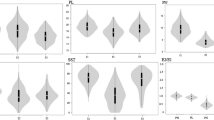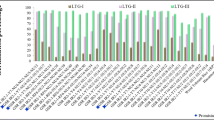Abstract
Quantitative trait loci (QTLs) for anther length (AL), length of the dehiscence that forms at the apex of the anther [apical dehiscence length (ADL)] and at the base of the anther [basal dehiscence length (BDL)], and the percentage of longitudinal dehiscence (LD) in rice (Oryza sativa L.) were analyzed using data from two consecutive years (2009 and 2010). Backcross inbred lines (BILs) derived from backcrossing of the rice cultivars (Nipponbare × Kasalath) × Nipponbare (95 lines) were used in both years for the detection of the QTLs. Each phenotype was significantly correlated between the 2 years, though its heritability was low. The anther dehiscence is strongly under control from both the environmental and genetic factors. Four major QTLs (α < 0.05) were detected for AL, three for ADL, four for BDL, and one for LD, using composite interval mapping. These QTLs explained 47–42, 32–25 and 36–28 % of the phenotypic variation in total for AL, ADL and BDL in BILs in 2009–2010, respectively, and for LD, 25 % in 2010. The phenotypic effects of the QTLs were examined using 54 chromosome segment substitution lines (CSSLs) derived from Nipponbare × Kasalath. Four of the detected QTLs had significant effects in CSSLs with Kasalath-type segments at marker positions linked with the QTLs, and the CSSLs can, therefore, be donors for breeding rice with high-temperature tolerance.







Similar content being viewed by others
References
Asins MJ (2002) Present and future of quantitative trait locus analysis in plant breeding. Plant Breed 121:281–291
Chase K, Adler F, Lark K (1997) Epistat: a computer program for identifying and testing interactions between pairs of quantitative trait loci. Theor Appl Genet 94:724–730
Hashimoto K (1961) On size of anther in rice plant varieties. Bull Hokkaido Study Meet Breed Crop Sci 2, 11 (In Japanese)
Horie T, Yajima M, Nakagawa H (1992) Yield forecasting. Agric Syst 40:211–236
Lander ES, Green P, Abrahamson J, Barlow A, Daly MJ, Lincoln SE, Newburg L (1987) MAPMAKER: an interactive computer package for constructing primary genetic linkage maps of experimental and natural populations. Genomics 1:174–181
Matsui T (2005) Function of long basal dehiscence of the theca in rice (Oryza sativa L.) pollination under hot and humid condition. Phyton 45:401–407
Matsui T, Kagata H (2003) Characteristics of floral organs related to reliable self-pollination in rice (Oryza sativa L.). Ann Bot 91:473–477
Matsui T, Omasa K, Horie T (1999) Mechanism of anther dehiscence in rice (Oryza sativa L.). Ann Bot 84:501–506
Matsui T, Omasa K, Horie T (2000) High temperatures at flowering inhibit swelling of pollen grains, a driving force for thecae dehiscence in rice (Oryza sativa L.). Plant Prod Sci 3:430–434
Matsui T, Omasa K, Horie T (2001) The difference in sterility due to high temperatures during the flowering period among japonica-rice varieties. Plant Prod Sci 4:90–93
Matsui T, Kobayashi K, Kagata H, Horie T (2005) Correlation between viability of pollination and length of basal dehiscence of the theca in rice under a hot and humid condition. Plant Prod Sci 8:109–114
Matsui T, Manigbas NL, Redona E, Tian X, Yoshimoto M, Hasegawa T (2009) Heat-induced floret sterility in rice: mechanisms of occurrence and tolerance. Gamma Field Symp 48:43–49
Miura K, Ashikari M, Matsuoka M (2011) The role of QTLs in the breeding of high-yielding rice. Trends Plant Sci 16:319–326
Osada A, Sasiprapa V, Rahong M, Dhammanuvong S, Chakrabondho H (1973) Abnormal occurrence of empty grains of indica rice plants in the dry, hot season in Thailand. Proc Crop Sci Soc Jpn 42:103–109
Saito K, Miura K, Nagano K, Hayano-Saito Y, Araki H, Kato A (2001) Identification of two closely linked quantitative trait loci for cold tolerance on chromosome 4 of rice and their association with anther length. Theor Appl Genet 103:862–868
Saito K, Hayano-Saito Y, Maruyama-Funatsuki W, Sato Y, Kato A (2004) Physical mapping and putative candidate gene identification of a quantitative trait locus Ctb1 for cold tolerance at the booting stage of rice. Theor Appl Genet 109:515–522
Satake T, Yoshida S (1978) High temperature-induced sterility in indica rices at flowering. Jpn J Crop Sci 47:6–17
Shah F, Huang J, Cui K, Nie L, Shah T, Chen C, Wang K (2011) Impact of high temperature stress on rice plant and its traits related to tolerance. J Agric Sci 149:545–556
Shimazaki Y, Satake T, Ito N, Doi Y, Watanabe K (1964) Sterile spikelets in rice plants induced by low temperature during the booting stage. Res Bull Hokkaido Natl Agric Exp Stn. 83:1–9 (in Japanese, with English summary)
Song XJ, Ashikari M (2008) Toward an optimum return from crop plants. Rice 1:135–143
Suzuki S (1981) Cold tolerance in rice plants with special reference to the floral characters. I. Varietal differences in anther and stigma length and effects of planting densities on these characters. Jpn J Breed 31:57–64 (in Japanese with English abstract)
Suzuki S (1982) Cold tolerance in rice plants with special reference to the floral characters. II. Relations between floral characters and the degree of cold tolerance in segregating generations. Jpn J Breed 32:9–16 (in Japanese with English abstract)
Tanno H, Xiong J, Dai L, Ye C (1999) Some characteristics of cool weather–tolerant rice varieties in Yunnan province, China. Jpn J Crop Sci 68:508–514 (in Japanese with English abstract)
Tian X, Matsui T, Li S, Yoshimoto M, Kobayashi K, Hasegawa T (2010) Heat-induced floret sterility of hybrid rice (Oryza sativa L.) cultivars under humid and low wind conditions in the field of Jianghan Basin China. Plant Prod Sci 13:243–251
Uchijima T (1976) Some aspects of the relation between low air temperature and sterile spikelets in rice plants. J Agric Meteorol 31:199–202
Wang S, Basten CJ, Zeng ZB (2012) Windows QTL Cartographer 2.5. Department of Statistics, North Carolina State University, Raleigh, NC. http://statgen.ncsu.edu/qtlcart/WQTLCart.htm
Xiao Y, Pan Y, Luo L, Deng H, Liu X, Tang W, Chen L (2011) Quantitative trait loci associated with pollen fertility under high temperature stress at the flowering stage in rice (Oryza sativa). Rice Sci 18:204–209
Ye C, Argayoso MA, Redoña ED, Sierra SN, Laza MA, Dilla CJ, Mo Y, Thomson MJ, Chin J, Delaviña CB, Diaz GQ, Hernandez JE (2012) Mapping QTL for heat tolerance at flowering stage in rice using SNP markers. Plant Breed 131:33–41
Zhang YS, Jiang L, Liu X, Liu S, Chen L, Zhai H, Wan J (2011) Heading date QTL in rice derived from an analysis of chromosome segment substitution lines. Plant Breed 130:185–191
Zhao L, Kobayashi K, Hasegawa T, Wang C, Yoshimoto M, Wan J, Matsui T (2010) Traits responsible for variation in pollination and seed set among six rice cultivars grown in a miniature paddy field with free air at a hot, humid spot in China. Agric Ecosyst Environ 139:110–115
Acknowledgments
Part of this work was financially supported by the Ministry of Agriculture, Forestry and Fisheries, Japan, through a research project entitled “Development of technologies for mitigation and adaptation to climate change in agriculture, forestry and fisheries”. We thank the National Institute of Agrobiological Sciences (http://www.nias.affrc.go.jp/index_e.html) for providing the rice seeds. We thank Shouta Yamada for his technical assistance.
Author information
Authors and Affiliations
Corresponding author
Electronic supplementary material
Below is the link to the electronic supplementary material.
Rights and permissions
About this article
Cite this article
Tazib, T., Kobayashi, Y., Koyama, H. et al. QTL analyses for anther length and dehiscence at flowering as traits for the tolerance of extreme temperatures in rice (Oryza sativa L.). Euphytica 203, 629–642 (2015). https://doi.org/10.1007/s10681-014-1291-1
Received:
Accepted:
Published:
Issue Date:
DOI: https://doi.org/10.1007/s10681-014-1291-1




